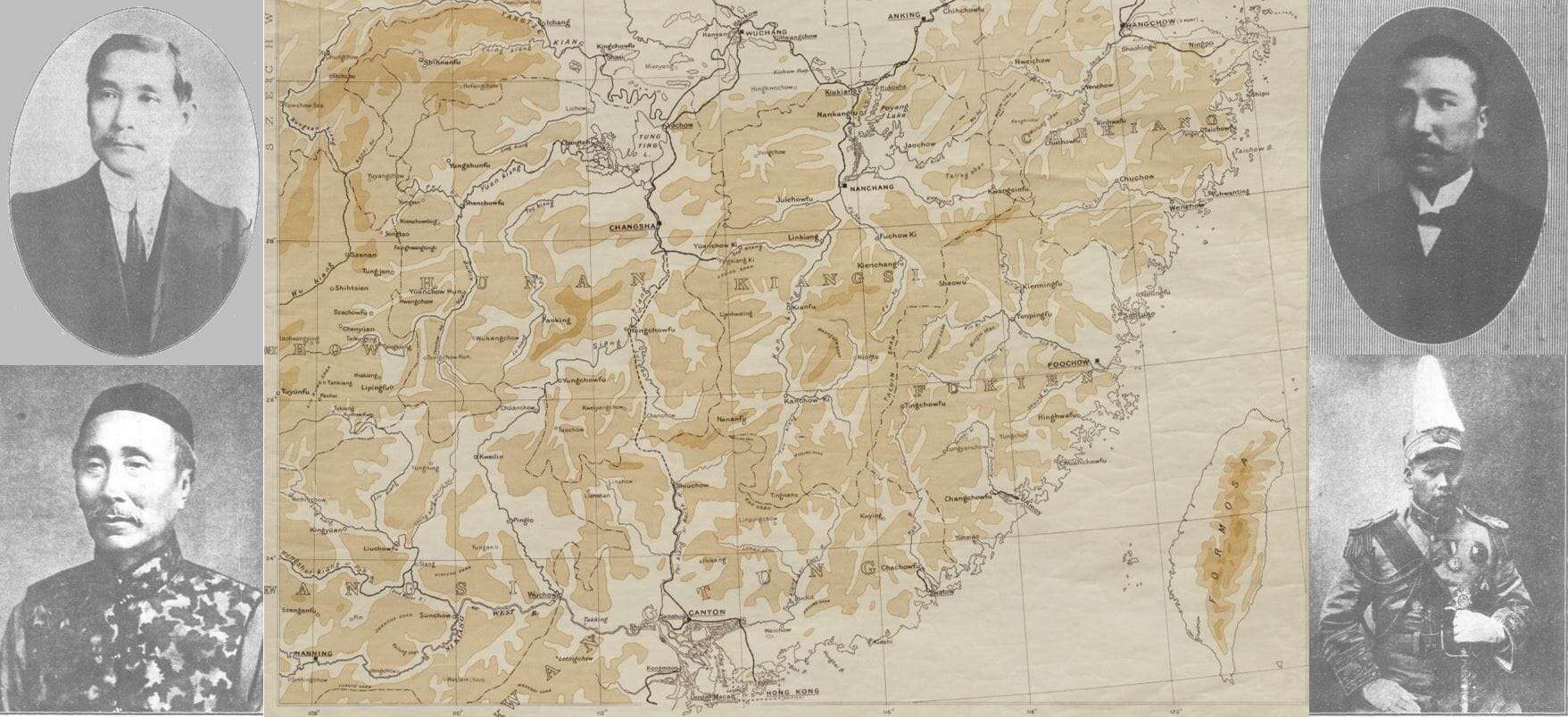│By Emery Pan, Gale Editor in Beijing│
A land plagued with poverty and political instability, China in the early twentieth century experienced the most drastic changes that had ever taken place in the country. This blog post explores this turbulent period in the history of China using primary sources from numerous Gale archives, including the China and the Modern World series.
Yuan Shih-kai (袁世凯) attempts to become emperor
The Revolution of 1911, led by Dr. Sun Yat-sen (孙中山), overthrew China’s last imperial dynasty, the Qing Dynasty, and founded the Republic of China. However, soon after the Revolution, Yuan Shih-kai (袁世凯) replaced Sun Yat-sen as the president of the Republic, and dissolved the Parliament and nulled the Provisional Constitution, China’s first Constitution, in hope of becoming an emperor himself. Yuan’s plan aborted in the face of huge nationwide opposition. His subsequent death in 1916 resulted in several years of fierce struggle among warlords across the country until a new political landscape was formed in 1918: the Peking National Government in the north with Tuan Chi-jui (段祺瑞) and Feng Kuo-chang (冯国璋) as leaders, versus the Canton National Government in the south led by Sun Yat-sen, Tang Shao-yi (唐绍仪), and Wu Ting-fang (伍廷芳).
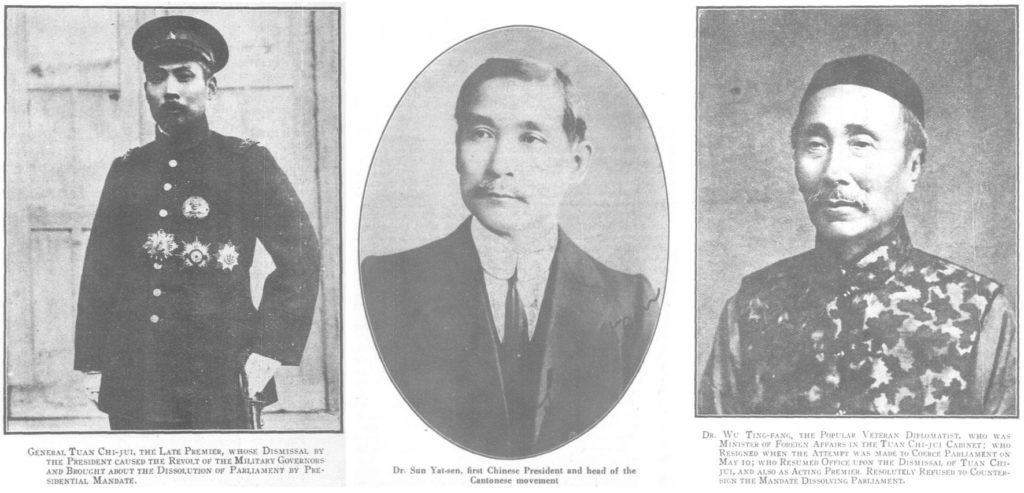
Middle: Dr. Sun Yat-sen. From “Dr. Sun Goes South.” The Far-Eastern Review, vol. XVI, no. 12, 1920, p. 662. Nineteenth Century Collections Online, https://link.gale.com/apps/doc/VFCRJJ907157797/GDCS?u=asiademo&sid=GDCS&xid=79fe9d59
Right: Wu Ting-fang. From “An Idol with Feet of Clay,” The Far-Eastern Review, vol. XIII, no. 14 (1917): 530, Nineteenth Century Collections Online https://link.gale.com/apps/doc/SVWEVT393079340/GDCS?u=asiademo&sid=GDCS&xid=f7651909

From “Chapter XIV The Government,” The China Year Book, (1919): 302. China and the Modern World, https://link.gale.com/apps/doc/ZSVFRX103362866/GDCS?u=asiademo&sid=GDCS&xid=34d4128f
Wars between the Kwangsi and Kwangtung factions
While the two governments were widely divided on many issues, including the Constitution, the southern warlords had their own friction, leading to the several wars fought between the Kwangsi and Kwangtung factions.
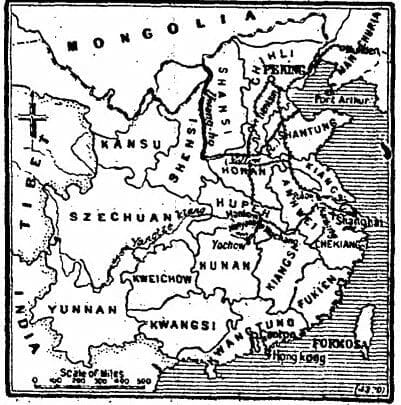
From “China Explained,” Times, April 18, 1922, 13, The Times Digital Archive, https://link.gale.com/apps/doc/CS219878034/GDCS?u=asiademo&sid=GDCS&xid=f0dd3dec
In early 1920, the two provinces of Kwangsi and Kwangtung were under the rule of Lu Yung-ting (陆荣廷), a southern warlord who became the General of Kwangsi and Kwangtung after driving Sun Yat-sen and his fellow “constitutionalists” out of Kwangtung. While seeking refuge in Shanghai, Sun allied himself with Tang Chi-yao (唐继尧), an ambitious Tuchun (Chinese warlord) ruling Yunnan Province, and General Chen Chiung-ming (陈炯明), an influential general in Canton who championed “Kwangtung for Kwangtungese,” preparing for recapturing Kwangtung.
In August 1920, the coalition forces launched wars against Lu Yung-ting from three sides: Tang Chi-yao first attacked western Kwangsi from Yunnan Province; another troop in Hunan Province assaulted Kwangsi from the north; and an army led by Chen Chiung-ming fought with Lu from Canton. After winning a decisive battle in Huizhou (惠州), Sun Yat-sen defeated Lu Yung-ting, who announced his withdrawal from Kwangtung on November 21, 1920. A detailed report about southern China’s situation at that time can be found in China Year Book (1921–1922), which is included in Gale’s China and the Modern World: Missionary, Sinology, and Literary Periodicals, 1817–1949.
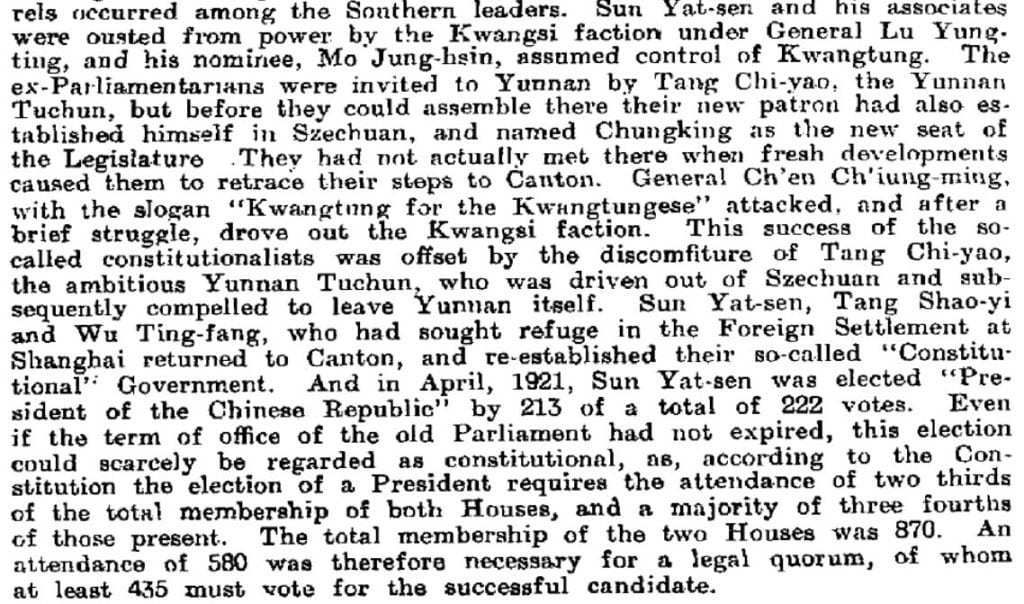
From “Chapter XXX. The Chinese Government,” The China Year Book, (1921–1922): 850, China and the Modern World, https://link.gale.com/apps/doc/HPTQMP184091960/GDCS?u=asiademo&sid=GDCS&xid=1f200487
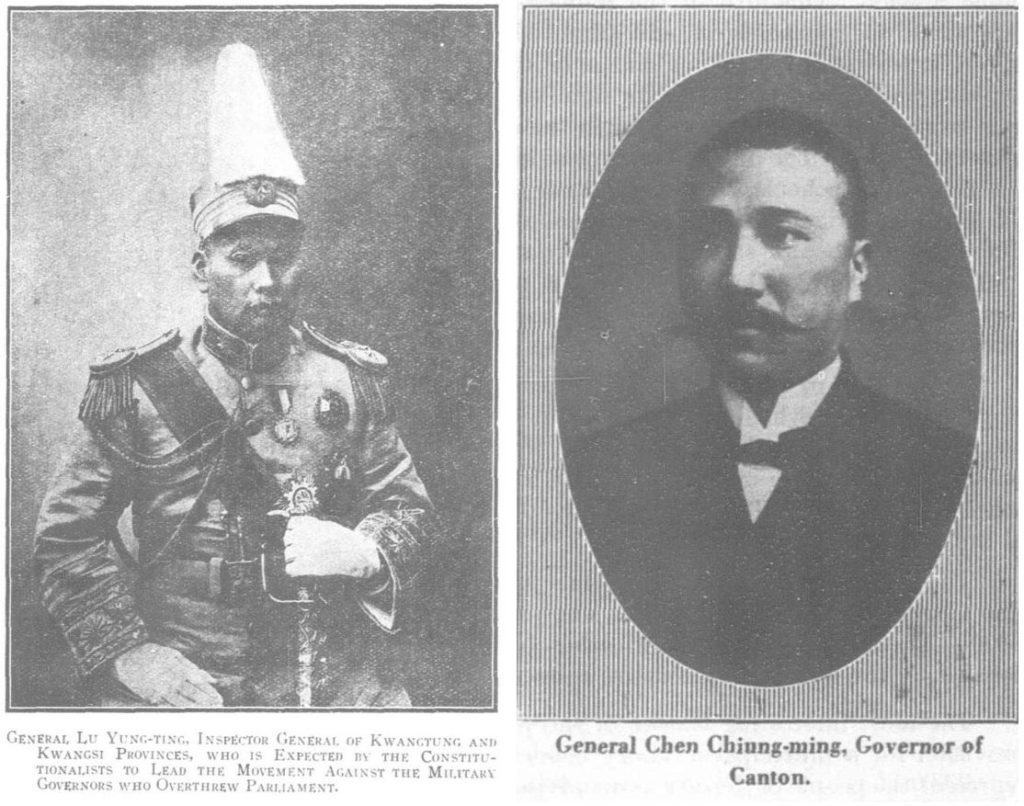
From “An Idol with Feet of Clay.” The Far-Eastern Review, vol. XIII, no. 14, 1917, 534. Nineteenth Century Collections Online, https://link.gale.com/apps/doc/SVWEVT393079340/GDCS?u=asiademo&sid=GDCS&xid=f7651909
Right: Chen Chiung-ming
From Keith, Orrin. “Commission Government in Canton.” The Far-Eastern Review, vol. XVIII, no. 2, 1922, 101. Nineteenth Century Collections Online, https://link.gale.com/apps/doc/IMESME982139998/GDCS?u=asiademo&sid=GDCS&xid=963d9dd1
Sun Yat-sen reestablishes parliamentary government
The triumph brought a temporary peace to southern China. Upon returning to Canton, Sun Yat-sen reestablished the parliamentary government. In May 1921, he was elected the president, with Chen Chiung-ming as the Minister of Interior, Concurrent Minister of War, and Governor and Commander-in-chief of Kwangtung forces; Tang Shao-yi as Minister of Finance; and Wu Ting-fang as Minister of Foreign Affairs.

From “Chapter XXX. The Chinese Government,” The China Year Book, (1921–1922): 858, China and the Modern World, https://link.gale.com/apps/doc/HPTQMP184091960/GDCS?u=asiademo&sid=GDCS&xid=1f200487
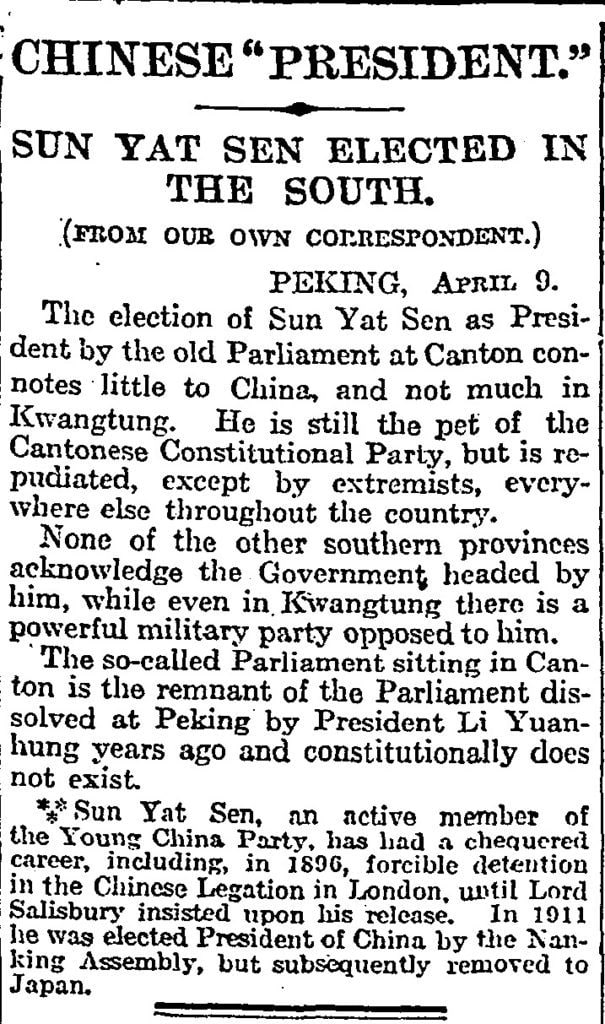
From “Chinese ‘President,” Times, April 11, 1921, 9, The Times Digital Archive, https://link.gale.com/apps/doc/CS154079371/GDCS?u=asiademo&sid=GDCS&xid=5817ec51
Lu Yung-ting declares war on Sun Yat-sen – again
However, the war did not end here. Becoming increasingly discontented with ruling Kwangsi only after his defeat, Lu had been scheming to win back Kwangtung and seeking help from the Peking government and northern warlords, who promised to render him financial and material support. Meanwhile, within Sun’s government, a discord occurred between him and Chen Chiung-ming on the future of the government: Sun wanted to subdue the northern warlords and unify China, while Chen was satisfied with ruling Kwangtung with no intention of expanding his territory.
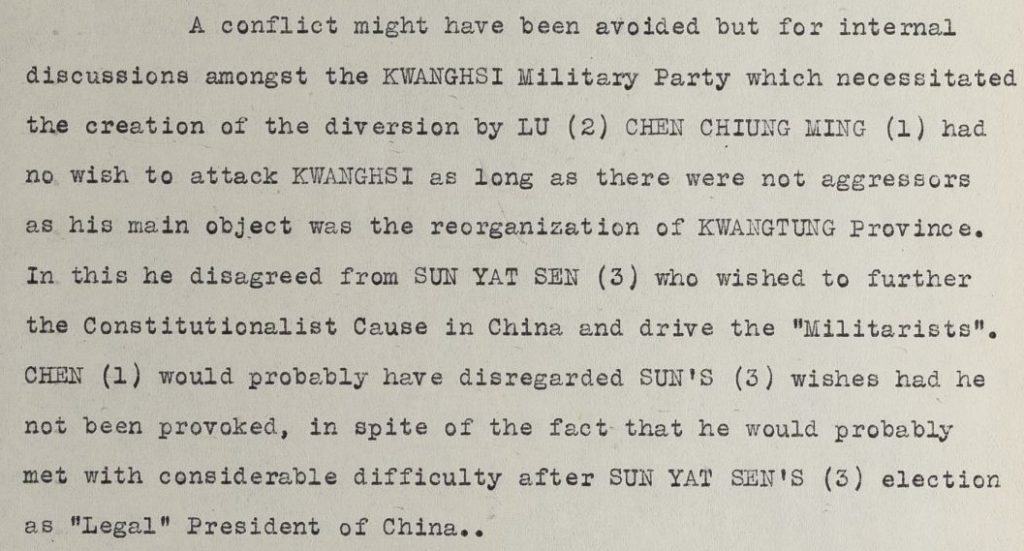
From “Occupation of Kwangsi by Kwangtung Troops. 8 Aug 1921–1911 Nov 1921, MS Political and Secret Department Records: Series 11: Departmental Papers: Political and Secret Annual Files (1912–1930) IOR/L/PS/11/203, P 4976/1921,” British Library, China and the Modern World, https://link.gale.com/apps/doc/WQHXUE681805709/GDCS?u=asiademo&sid=GDCS&xid=186b8dfb
In May 1921, with Chen Pingkun (陈炳坤) as the commander, Lu Yung-ting declared war on Sun Yat-sen again, and attacked Kwangtung from four sides: Pakhoi (Peihai, 北海), Watlam (Yulin, 玉林), Wuchow (Wuzhou, 梧州), and North River (Beijiang, 北江). Facing Lu’s attack, Sun Yat-sen immediately ordered Chen Chiung-ming to fight back. Chen, initially reluctant to fight Lu because of his disagreements with Sun, had no choice but to defend Kwangtung.
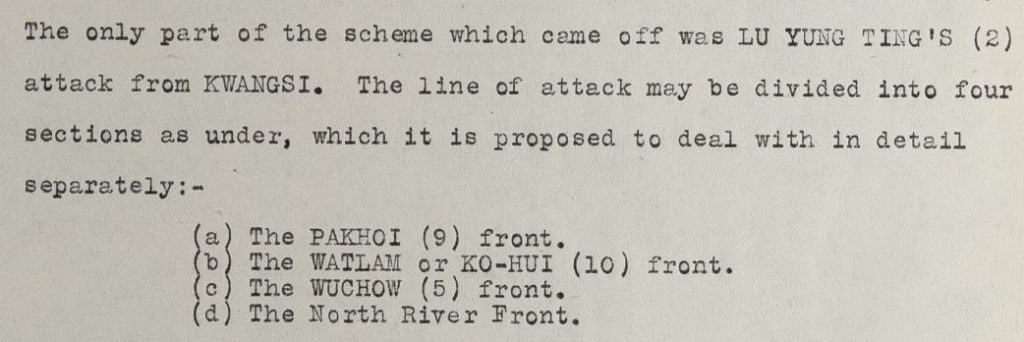
From “Occupation of Kwangsi by Kwangtung Troops. 8 Aug 1921–1911 Nov 1921, MS Political and Secret Department Records: Series 11: Departmental Papers: Political and Secret Annual Files (1912–1930) IOR/L/PS/11/203, P 4976/1921,” British Library, China and the Modern World, https://link.gale.com/apps/doc/WQHXUE681805709/GDCS?u=asiademo&sid=GDCS&xid=186b8dfb
Sun and Chen’s army triumph and unify Kwangtung and Kwangsi
In his report submitted to British Foreign Office on August 8th, 1921, J. W. Jamieson, then consul-general in Canton, wrote: “The forces engaged on both sides were approximately Kwangtung 80,000 Kwangsi 70,000 but the Kwangsi troops appear to have been short of ammunition and money, and all Peking’s efforts to get supplies through to them failed.” This report can be found in Gale’s China and the Modern World: Diplomacy and Political Secrets,1869–1950. After months of concerted efforts, Sun and Chen’s army triumphed and unified Kwangtung and Kwangsi. In August 1921, Lu Yung-ting fled to Shanghai, marking the end of the Kwangtung–Kwangsi war. In 1927, Lu died in Shanghai.
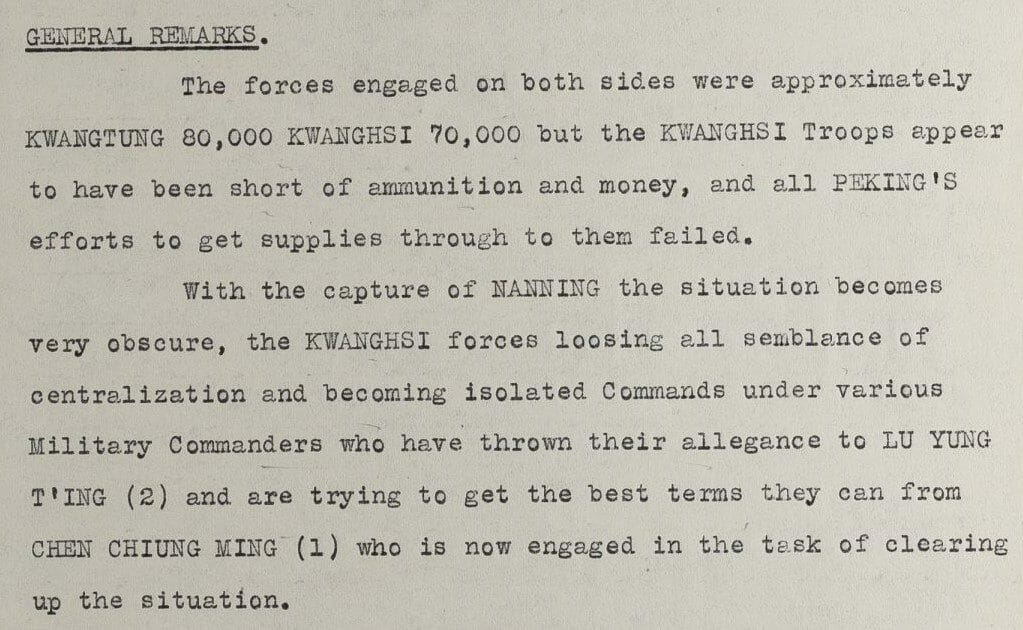
From “Occupation of Kwangsi by Kwangtung Troops, 8 Aug 1921–11 Nov 1921, MS Political and Secret Department Records: Series 11: Departmental Papers: Political and Secret Annual Files (1912–1930) IOR/L/PS/11/203, P 4976/1921,” British Library, China and the Modern World, https://link.gale.com/apps/doc/WQHXUE681805709/GDCS?u=asiademo&sid=GDCS&xid=186b8dfb
The emergence of Chiang Kai-shek (蒋介石)
A notable thing in the war was the involvement of Chiang Kai-shek (蒋介石). Chiang joined the battle in May 1921 upon Sun Yat-sen’s request, and his exceptional performance earned Sun’s trust. Later, he rescued Sun in the struggle with Chen Chiung-ming and was appointed president of the Whampoa Military Academy (黄埔军校), an institution best-known for having produced many prestigious commanders involved in many of China’s conflicts in the twentieth century.
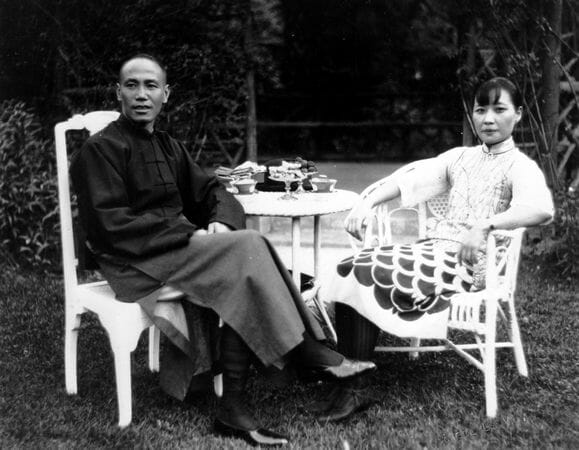
Gen. Chiang Kai-shek and his wife, Soong Mei-ling, are photographed in the garden of their home at Nanchang, China, on Oct. 1, 1927. Chiang Kai-shek, also known as Jiang Jieshi, succeeded Sun Yat-sen as leader of the National People’s Party, KMT. Mei-ling Soong is a graduate of Wellesley College in the U.S.A. (AP Photo)
From “Chiang Kai-shek.” Washington, D.C. Bureau Image Collection, Primary Source Media, 1927. Associated Press Collections Online, https://link.gale.com/apps/doc/KXAQJH204336725/GDCS?u=asiademo&sid=GDCS&xid=2252586e
With the unified Kwangtung and Kwangsi as his base, Sun Yat-sen started planning a northern expedition with a view to wiping out the northern warlords and unifying the country. Regrettably, he passed away in 1925, and thus did not live to see his dream come true. Over the next three years, Chiang Kai-shek inherited his mantle and eventually unified the country in 1928.
If you enjoyed reading this post about Sun Yat-sen and the Kwangtung–Kwangsi Conflicts in the 1920s, you might like:
- Dr. Sun Yat-sen, the man who led China from Empire to Republic
- An American Missionary with Two Motherlands: Joseph Beech and West China Union University
- Rediscovering China and the World in the Nineteenth Century
Blog post cover image citation: Images of individuals found throughout this post, combined with Map of Southern China in 1927. From Great Britain. War Office General Staff Geographical Section. “China 1:2,000,000, Series GSGS 3839.” In British Library: Ministry of Defense Maps. Primary Source Media, 1927. Nineteenth Century Collections Online, https://link.gale.com/apps/doc/CKOAHX917585637/NCCO?u=asiademo&sid=NCCO&xid=3d266b97&pg=3

